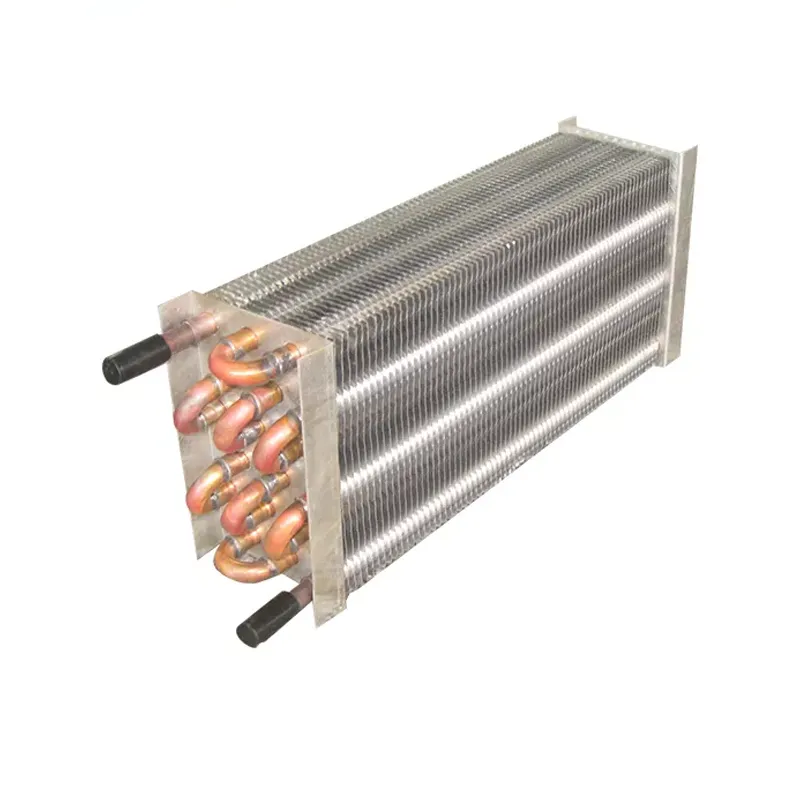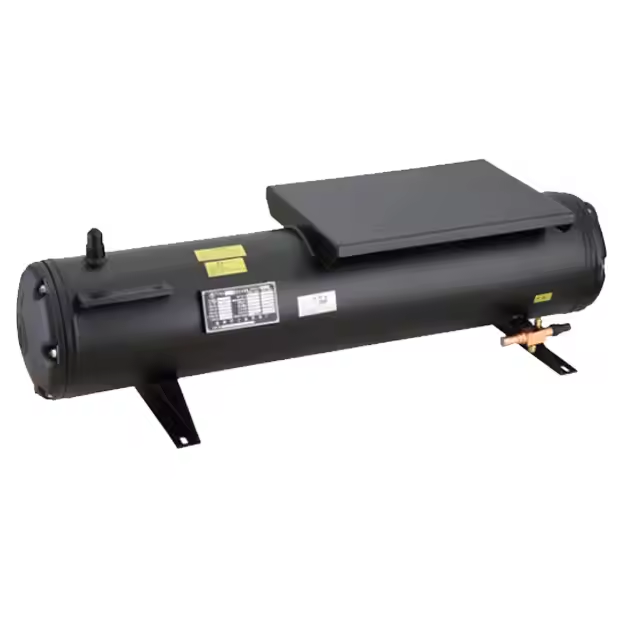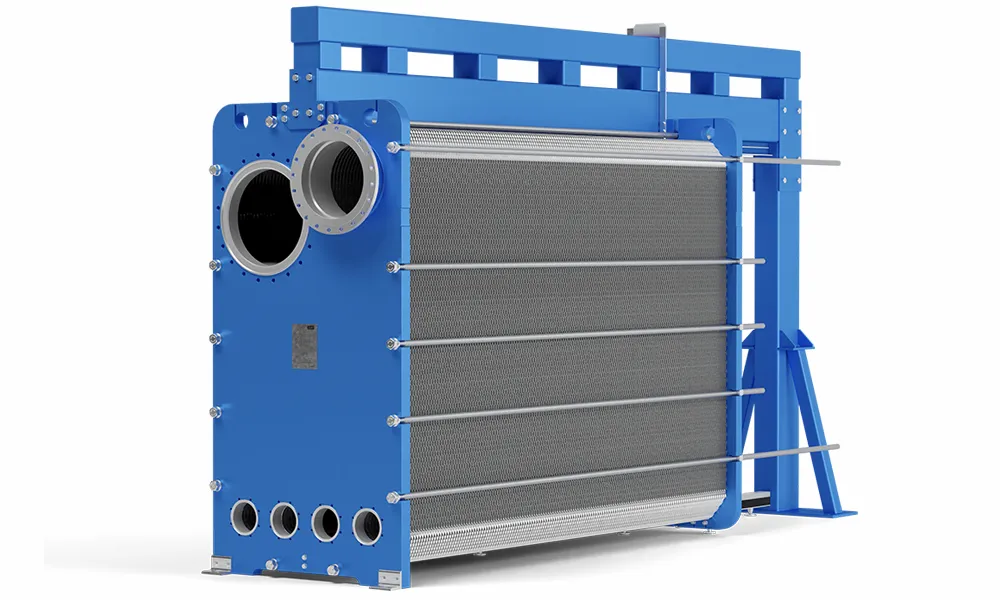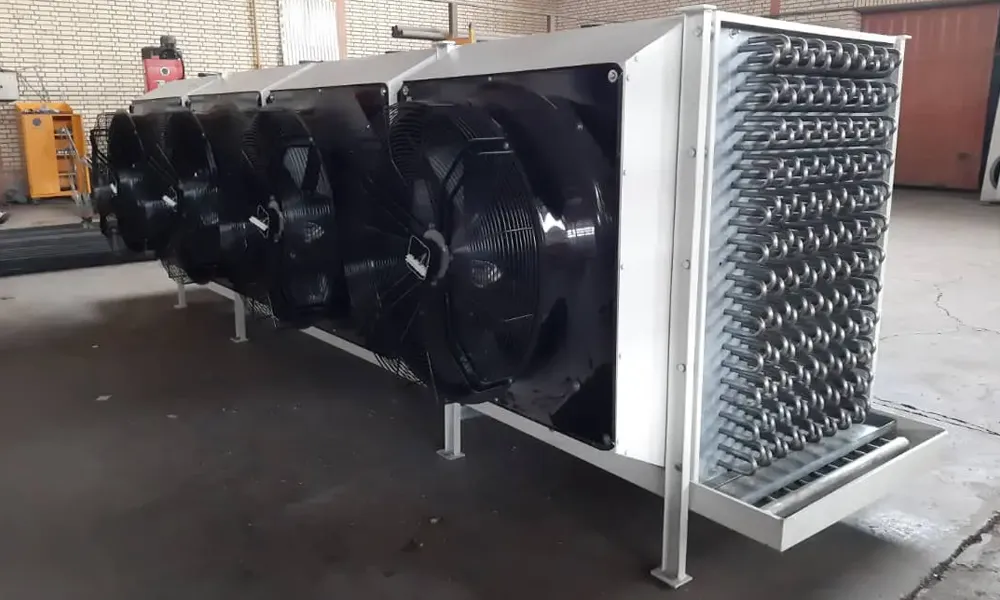
The evaporator is the beating heart of all refrigeration and air conditioning systems. It is a vital component that plays a key role in heat transfer and cold generation. In fact, the evaporator is where the liquid refrigerant turns into gas and, in doing so, absorbs ambient heat and reduces the surrounding temperature.
Given the wide range of applications for refrigeration and HVAC systems in various industries—from food and pharmaceuticals to buildings and vehicles—different types of evaporators with various designs and functionalities are produced.
For this reason, we have decided to provide, on this page of the Tabadol Gostar Boran website, a comprehensive overview of the types of evaporators, their working principles, applications, and the key factors in selecting the appropriate type. So stay with us until the end for more in-depth and complete information.
An evaporator is one of the most important components in refrigeration and air conditioning systems. It is an intelligent part that uses the phenomenon of evaporation to absorb heat from the environment and transfer it to the liquid flowing through it.
In fact, the evaporator acts like a sponge that absorbs environmental heat and then transfers it to the system for dissipation.
This process involves the phase change of the refrigerant from liquid to gas, which is why the evaporator is regarded as the heart of every cooling system.
The operation of the evaporator is such that low-temperature liquid refrigerant enters the evaporator coils. Here, the refrigerant absorbs the ambient heat, evaporates, and changes into gas.
This phase change causes the temperature of the surrounding environment to drop, creating a cooling effect. The refrigerant gas is then drawn in by the compressor and continues to other parts of the system to complete the refrigeration cycle.
Therefore, given the critical role of the evaporator in the performance of cooling systems, selecting the right type of evaporator and proper system design plays a significant role in the system’s efficiency and longevity.
Evaporators come in various types. From tubular and plate models to other classifications based on their applications across different industries.
Below, we will describe some of the main categories of evaporators and their typical uses.
Ammonia evaporators use ammonia gas as a refrigerant. Due to its excellent thermal properties, high efficiency, and low cost, they are widely used in large-scale industries and industrial cold storage facilities.
Ammonia has a high heat absorption capacity, enabling rapid temperature reduction and creating optimal storage conditions for various products.
Since ammonia easily evaporates and condenses, refrigeration systems based on ammonia generally offer high energy efficiency.
As a result, these characteristics make ammonia evaporators a preferred choice in the food industry, meat processing facilities, and frozen goods storage units.
However, using ammonia evaporators requires strict safety measures because ammonia is a toxic and flammable gas.
Therefore, these systems must be designed and installed carefully, following safety standards. Safety equipment such as gas leak detectors, proper ventilation systems, and scheduled maintenance plans must be implemented.
In addition, technical specialists should regularly inspect the system to ensure proper operation and minimize potential risks. Despite their advantages, ammonia evaporators demand professional management and a high level of operational responsibility.
Freon evaporators use Freon gases such as R134a, R22, and R410a as refrigerants. Due to their chemical stability and high safety levels, they are widely used in many refrigeration and HVAC systems.
These evaporators are commonly found in household refrigerators, air conditioners, and HVAC systems, playing a vital role in maintaining ideal temperatures and air quality.
They operate by converting the refrigerant from liquid to gas while absorbing ambient heat during the phase change, resulting in a cooling effect.
One key advantage of Freon evaporators is the use of high thermal conductivity materials such as copper or aluminum, which enhance heat transfer efficiency.
Their compact and lightweight design, combined with ease of installation and maintenance, makes them an ideal choice for both residential and commercial applications.
Moreover, the diversity of Freon gases and advancements in their production technology have contributed to lower energy consumption and reduced environmental impact.

Cold storage evaporators are among the most critical components of cold storage systems, responsible for reducing temperature and preserving products in optimal conditions.
These evaporators are categorized into two types based on the target temperature: above-zero and sub-zero cold rooms. Each type has specific characteristics tailored to the nature of the stored products and the specific requirements of the cold storage environment.
This type of evaporator is used for storing products that require temperatures above zero degrees Celsius, such as fruits and vegetables. It is specifically designed to maintain ambient humidity and prevent the drying out of sensitive products.
Additionally, above-zero evaporators are typically equipped with fans to evenly distribute cold air throughout the entire cold storage space.
Using these evaporators helps preserve the freshness and quality of sensitive products like fruits and vegetables for a longer period.
Evaporators used in sub-zero cold storage rooms are mainly intended for storing products that require freezing, such as meat, poultry, fish, and other frozen goods.
These evaporators operate at temperatures below zero degrees Celsius and are usually equipped with systems that prevent the formation of ice and frost on their surfaces.
They are engineered for rapid and efficient heat exchange to freeze food items in the shortest time possible while preserving their original quality.
Moreover, some of these evaporators feature automatic defrost systems that prevent ice buildup on the evaporator fins and contribute to higher system efficiency.
These evaporators must also be capable of continuous operation under harsh conditions and very low temperatures to keep food products frozen over extended periods.
Based on their structural design, evaporators are divided into several categories:
This type of evaporator consists of a cylindrical shell containing a number of internal tubes. The refrigerant gas passes through the tubes, which are surrounded by a fluid within the shell that needs to be cooled.
Heat transfer occurs through the tube walls between the refrigerant and the process fluid. Due to their simple construction and ability to withstand high pressure, shell and tube evaporators are widely used across industries such as food, pharmaceuticals, and chemicals.

Plate evaporators are composed of metal plates arranged in parallel with minimal spacing. The refrigerant and the fluid to be cooled alternate their flow between these plates.
This design provides a large surface contact area between the refrigerant and the fluid, resulting in high thermal efficiency. Plate evaporators are commonly used in dairy processing, electroplating, and food industries.
Finned or air-cooled evaporators are coils over which air is blown using fans. The refrigerant passes through the coil tubes and evaporates by absorbing the heat from the air. These evaporators are widely used in HVAC systems and cold storage rooms due to their simple construction and low cost.
Ice bank evaporators consist of a water tank in which refrigerant-filled coils are submerged. As the refrigerant evaporates, the water inside the tank freezes, forming a layer of ice on the coils. This ice layer acts as a thermal insulator and prevents direct heat transfer between the refrigerant and the surrounding environment.
Finally, dry coil evaporators are similar to finned evaporators, except that they do not use fans to blow air. These types of evaporators are mainly used in low-capacity HVAC systems and air handling units.
Chiller evaporators play a vital role in large HVAC systems and industrial chillers. They are used to cool water or other fluids, which in turn reduce the temperature of the environment or specific equipment.
Chiller evaporators, due to their high cooling capacity, are used in commercial buildings, factories, and power plants.
These evaporators are divided into two main types based on their cooling mechanism: air-cooled and water-cooled.
The first type is the air-cooled evaporator, which transfers its heat to the surrounding air. This type is mostly used in locations with limited water access and is highly popular due to its ease of installation and maintenance.
Air-cooled evaporators do not require cooling towers, resulting in lower initial and maintenance costs. However, their performance may be affected by high ambient temperatures, making them less suitable for tropical regions.

The second type is the water-cooled evaporator, which transfers heat to water and is commonly used in systems that include cooling towers.
These evaporators perform exceptionally well under high-temperature conditions, as water as a cooling medium enhances heat exchange efficiency.
Water-cooled evaporators are better suited for large industrial and commercial projects. However, they require more complex systems for water circulation and temperature control, which may increase operational costs.
Ultimately, the choice between the two types depends on environmental conditions, operational costs, and the specific needs of each project.
Split evaporators are another type commonly used to create a cool and comfortable indoor environment in buildings.
This intelligent unit, typically installed inside the split system, consists of coiled copper tubes and aluminum fins. As warm air from the room passes over the evaporator, it contacts the cold refrigerant flowing through the copper tubes.
During this contact, the heat from the ambient air is transferred to the refrigerant, causing it to evaporate. This evaporation process reduces the air temperature, and the cooled air is returned to the room.
The specific design of split evaporators—especially the use of spiral copper tubing and aluminum fins—increases the contact surface between the air and refrigerant, significantly enhancing heat transfer efficiency.
Additionally, powerful fans within the evaporator ensure fast air circulation and uniform distribution of cool air in the space.
Split evaporators also typically include washable air filters that help purify the air and remove suspended particles.
The shell and tube evaporator is one of the most efficient and widely used types of heat exchangers, playing a pivotal role in various industries.
This type consists of a cylindrical shell and a bundle of tubes inside it, arranged either parallel or perpendicular to the flow direction of the fluid within the shell.
The refrigerant flows inside the tubes and transfers its heat to another fluid flowing in the shell. This simple yet effective structure enables highly efficient heat exchange and makes shell and tube evaporators ideal for a wide range of applications, from food and pharmaceutical industries to petrochemicals and power plants.
Key advantages include high heat transfer efficiency, excellent reliability, long lifespan, design flexibility, and ease of cleaning.
Moreover, due to their simple construction, shell and tube evaporators generally require lower maintenance and repair costs compared to some other types.
However, selecting the appropriate shell and tube evaporator for each specific application depends on factors such as the type of fluids involved, operating temperature and pressure, corrosion levels, and spatial constraints.
Design engineers can optimize these evaporators by adjusting parameters such as the number of tubes, tube diameter, material selection, shell-side flow patterns, and more to achieve optimal performance under the desired operating conditions.
Evaporator Type | Refrigerant Fluid | Application | Key Features |
|---|---|---|---|
Ammonia | Ammonia | Food industry, chemical industry, industrial cold storages | High capacity, high efficiency |
Freon | Freon gases | HVAC systems, small cold storages | Easy installation, low maintenance cost |
Above-zero cold storage | Various types | Storage of fruits, vegetables | Higher operating temperature |
Sub-zero cold storage | Various types | Storage of meat, fish | Lower operating temperature |
Chiller | Water or glycol | Central HVAC systems | High capacity, precise temperature control |
Split | Various types | Wall-mounted and floor-standing split systems | Easy installation, compact design |
Shell and tube | Various types | General-purpose applications | Simple structure, low construction cost |
Each type of evaporator introduced above on this page is priced based on various factors. For example, the price of shell and tube evaporators usually depends on the diameter and thickness of the shell, the size and thickness of the tubes, the type of fan, and the number of circuits.
As another example, the price of cold storage evaporators mainly depends on cooling capacity, pipe size and length, fin density, and the fan’s air suction capacity.
Therefore, it is not possible to provide a fixed and precise price for evaporators.
However, you can contact the experts at Tabadol Gostar Boran to get detailed information about evaporator costs and purchasing options.
If you intend to purchase a high-quality evaporator tailored to your system’s needs, you can contact Tabadol Gostar Boran. Our company offers a wide range of evaporators in different capacities and materials to meet your requirements.
Our experts will help you select the best evaporator by considering the type of refrigerant, required thermal capacity, and your environmental conditions.
For more information and free consultation, contact the experts at Tabadol Gostar Boran and take advantage of buying from a trusted brand.
We assure you that purchasing from Tabadol Gostar Boran will be a secure investment for your cooling system.
If you need consultation or wish to start a project, please contact us through the form below. Our support team is proud to be at your service for all your needs.
Answers to the most frequently asked questions directed to the experts at Tabadol Gostar Boran:
Regular maintenance, keeping the evaporator clean, using anti-corrosion materials, and preventing scaling can increase the useful life of an evaporator.
A dry evaporator uses air to cool the refrigerant, whereas a wet evaporator uses water or other fluids for this purpose.
Yes, many evaporators are repairable. However, in some cases, replacing the evaporator entirely might be more cost-effective.
Yes, some evaporators may produce noise during operation. This is usually due to vibrations in the pipes or fans and can be reduced with proper insulation.
To choose the right evaporator, factors such as required cooling capacity, type of refrigerant, environmental conditions, budget, and system application must be considered. It is best to contact us for the most suitable option.
With over two decades of continuous and successful activity in the refrigeration industry, Tabadol Gostar Booran is recognized as one of the leading manufacturers and suppliers of refrigeration machinery and equipment in Iran and the Middle East.
Head Office: Tehran, Keshavarz Blvd, between Jamalzadeh and Kargar Streets, No. 310, 4th floor, Unit 9
Factory Address: Tehran, Shamsabad Industrial Zone, Azadi Blvd, Narges 4 Alley, No. 11
Phone: +98 21 66429698 / +98 21 66429699
Fax: +98 21 66429698
Email: Tabadolgostar@gmail.com
All rights reserved for the Tabadol Gostar Booran website. 2025